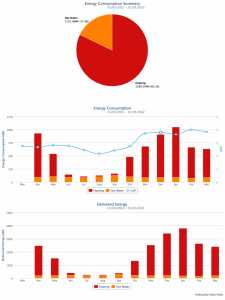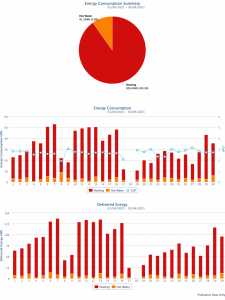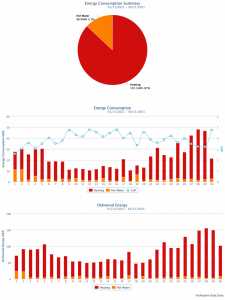really good data that supports what a lot of us are trying. A couple of questions (1) I think you are using weather compensation but still using external thermostats; is that right? To give my supplier credit, that's how they set up my system and (2) Do you have the total energy delivered over the two periods? That would be another good comparison. (sorry if I've missed this)
I've also heard the 'people will complain if rads aren't hot' comment.
Kev
Thanks Mark.
Excellent data once again.
I fully agree about a database or something similar, but also the need to educate both customers and installers about how to operate ASHP's in the most efficient manner. You are doing a great job, keep spreading the gospel.
One of the reasons that I created the modelling tool, was so that it would be possible to probably find the approximate settings for the weather compensation curve, without the need for continual trial and error.
@derek-m I suppose how close are we to having a modelling tool that can suggest an optimum weather dependent curve/other optimum settings as @MarkC suggested?
Without taking this OT (and not withstanding my gas/ASHP setup) it is difficult to know what the optimum is and I'm still trying to get my head around the different curves suggested and the impact of adjusting these.
The modelling tool that I produced appears to give reasonably accurate results for Ecodan 14 kW ASHP's, provided that fairly accurate data for heat demand and total heat emitter output capacity is entered. It could be used for other sizes of Ecodan heat pumps and those from other manufacturers, provided that operating data obtained from standard testing procedures can be obtained and entered into the spreadsheets to replace that for the 14 kW Ecodan.
You could still do the modelling for your ASHP, by assuming that the gas boiler is not functioning, so only the heat pump was operating. The modelling tool would calculate the required water flow temperature for ambient air temperatures from 20C down to -15C.
Posted by: @kev-mreally good data that supports what a lot of us are trying. A couple of questions (1) I think you are using weather compensation but still using external thermostats; is that right? To give my supplier credit, that's how they set up my system and (2) Do you have the total energy delivered over the two periods? That would be another good comparison. (sorry if I've missed this)
I've also heard the 'people will complain if rads aren't hot' comment.
Kev
I'm assuming by external you mean external to the ASHP, not outside in the fresh air.
1. I have 4 internal thermostats (Heatmiser and Nest) and they are all set to 25ºC (so effectively now calling for heat all the time). The ASHP uses it's own external (i.e. outside the house) thermistor to read ambient outside air temp and set the flow heat.
2. 8-9/12 produced 218.4kWh, 10-11/12 produced 255.9kWh
I now have a full years metered ASAP energy usage that I can report on.
The headline is that energy usage has come in just about bang on what was expected.
And the system is performing very well. We have had no issues with the pump.
According to the MCS estimates that were produced, the energy requirements for heating and DHW were 21,571 kWh.
And the estimated energy usage for the ASHP was 6765 kWh.
For the year the system has actually used 6441kWh for DHW and heating.
Comparing ASHP to LPG which is what I moved from:
2020 I spent £1500 on LPG. This was with the heating set at 18ºC from 22:00 until 17:00 and 22ºC 17:00 until 22:00.
At the time of commissioning (the good ol’ days!) I was paying 15p per kWh for electricity. Assuming prices would have remained stable.
£0.15 x 6441 = £966 for a house that is constantly 22ºC.
So all things being equal and assuming all energy prices have risen a similar percentage, the move from LPG to ASHP does ‘seem’ to be the right move.
That being said:
Even with the RHI deducted the new system cost £3000. The installation was £14K, RHI is paying back £11K.
I had to pay £1000 to have the LPG tank removed.
I’ve pulled out a couple of months for comparison.
In April the system was running on a set flow temp of 50ºC and the heating was controlled with internal thermostats.
As discussed in other chats/threads this is done so the system matches the usage of a gas boiler type installation so customers are more comfortable with how to control it.
We also had the thermostats set to:
22:00 - 6:00 = 16ºC
06:00 - 18:00 = 18ºC
18:00 - 22:00 = 22ºC
22ºC feels comfortable for us so the house did feel cool and I was attempting to use as little energy as possible. Not a comfortable setting for us.
The heating used 838.4 kWh and delivered 2285 kWh of heating.
April COP was 2.6
Average outside temp was 6.38ºC
As we got into October and the energy usage began to rise we started looking into optimising the system on the forum and changed the settings to weather compensation.
As part of this move we set the system up to deliver a constant 22ºC internal temperature, 24 hours a day. The thermostats no longer controlled the system as the weather compensation regulates the flow temperature.
The heating used 593.1 kWh and delivered 2339 kWh of heating.
November COP was 3.7
Average outside temp was 8.08ºC
Granted, April was slightly colder than Nov outside. Both months required a similar amount of heating.
But, when using a set 50ºC flow temp, April used a third MORE electricity to deliver a cooler, less comfortable internal temperature.
So with a set up like ours, (UFH downstairs and rads upstairs) my take is that weather compensation and 24/7 heating is the way to go.
Good results and looks like you made the right decision. Even allowing for the warmer November you're still using a lot less power. I did the same sort of experiment and reckoned weather compensation was 15-20% less but I was using 45 deg fixed flow. I also kept the temperature the same all day in both scenarios.
The other thing you've mentioned that isn't often talked about is comfort. I prefer a constant temperature rather than ups and downs and weather compensation does this better than thermostats, even when maintaining a constant temperature.
Retrofitted 11.2kw Mitsubishi Ecodan to new radiators commissioned November 2021.
14 x 500w Monocrystalline solar panels.
2 ESS Smile G3 10.1 batteries.
ESS Smile G3 5kw inverter.
-
Have Consumers Been Lied to About the Efficiency of Heat Pumps Made in China?
5 months ago
-
Ecodan consuming 100kwh per day in new build!!!
6 months ago
-
Help with understanding my Mitsubishi Ecodan air source heat pump
8 months ago
-
Efficiency Concerns on newly installed Mitsubishi Ecodan 8.5kW
8 months ago
-
Running my new Nibe ASHP efficiently
11 months ago
- 26 Forums
- 2,364 Topics
- 53.6 K Posts
- 284 Online
- 6,029 Members
Join Us!
Worth Watching
Latest Posts
-
RE: Octopus Cosy Heat Pump Owners & Discussion Thread
Yes. In addition or instead. The point us that trv b...
By JamesPa , 9 hours ago
-
-
RE: ASHP sizing - value of Heat Transfer Coefficient
@toodles Hi, my friend recently made a video about heat...
By HeatPumpMe , 14 hours ago
-

How long will your energy contract last?
Some heat pump tariffs don’t run as long as a heat pu...
By Toodles , 2 days ago
-

@morgan They are unsupervised these days, can’t get the...
By Toodles , 2 days ago
-
-

RE: Setback savings - fact or fiction?
Exactly. We only need to compare conditions, to decide ...
By cathodeRay , 3 days ago
-
RE: Balancing financial efficiency and comfort using the Octopus Cosy tariff
I found because I have very low heat loss I can set bac...
By RadWhisperer , 3 days ago
-
RE: Need Help Optimising My Rushed ECO4 Install: 12kW Bosch Heat Pump
Welcome @mickamills We too have an oversized 12kW Sa...
By Old_Scientist , 3 days ago
-
RE: My Powerwall 3 Consumes 3-4 kWh/Day in Self-Consumption: Is This Normal?
@caron I can confirm that the power usage of the PW3 is...
By Old_Scientist , 3 days ago
-
RE: Speedcomfort radiator fans
Thats true, but having tried (and succeeded) in constru...
By JamesPa , 3 days ago
-
RE: Solis S6-EH1P8K-L-PLUS – Why I Chose It and What I’ve Learned So Far
@bash brilliant, thanks for the feedback
By energy9165 , 3 days ago
-

RE: Heat Pump Heats the House… But It’s Not Cosy. Emitter Changes or System Tweak?
@alastair There I was, feeling grumpy, he said “Cheer u...
By Toodles , 3 days ago
-
RE: Grant Aerona: Is there a setting to keep the 2-port valve open during pump blockade
Depends on OAT. Mine cycles at OAT>10 and of course...
By JamesPa , 3 days ago
-
RE: New Fogstar 15.5kWh upright solution
@transparent My conclusion is as you have noted, tha...
By Bash , 3 days ago
-
RE: Mitsubishi Ecodan R290 10kW performance
And to you too. Wishing you a very enjoyable festive s...
By Sheriff Fatman , 4 days ago
-

RE: External pipework insulation
They do? But that isn't apparent from the photos we'r...
By Transparent , 4 days ago
-

RE: Say hello and introduce yourself
@velcro welcome to the forums. Please feel free start a...
By Mars , 4 days ago
-
Daikin EDLA11D3V3 DHW Settings
I have a newly installed EDLA11D3V3 which I'm still get...
By Velcro , 4 days ago
-
RE: Midea ASHP – how to set weather compensation
@curlykatie did you get sorted with this?
By MickaMills , 4 days ago







